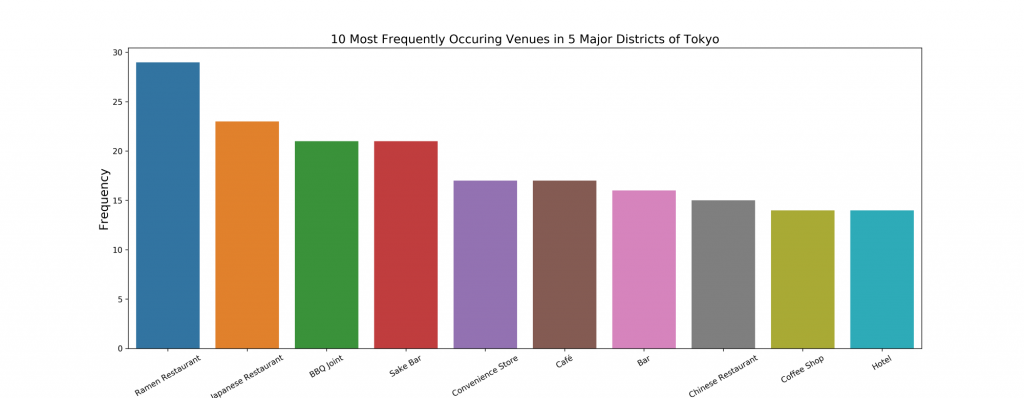
Opening a Restaurant in Tokyo, Japan
Here is the final IBM Capstone Project, which comprised the blog and snippet of the code written in the Jupyter notebook. The objectives of these assignments are to define a business problem, research data on the web and ability to use foursquare location data to compare different districts within the wards of Tokyo. The choice of a city depends on how to figure out which neighborhood is suitable for starting a restaurant business.
1. Discussion and Background of the Business Problem:
Tokyo is the most populous city in the world. Now the city is rank third in the global economic power index, Tokyo is suggest the business hub if one wish to start one.
Researching during the daytime, especially in the morning and lunch hours, office areas provide enormous opportunities for restaurants. Reasonably priced (one lunch meal 8$) shops are usually always full during the lunch hours (11 am — 2 pm), and, given this scenario, we will go through the benefits and pitfalls of opening a breakfast cum lunch restaurant in highly dense office places. Usually, the profit margin for a decent restaurant lies within the 15−20percentage range, but it can even go high enough to 35%, as discussed in this project. Tokyo has up of 23 wards (municipalities) but, I will later concentrate on five busiest wards of Tokyo — Chiyoda, Chuo, Shinjuku, Shibuya, and Shinagawa, to target daily office workers.
I will go through steps of this project and address them separately. I first outline the initial data preparation and describe future steps to start the battle of neighborhoods in Tokyo.
Target Audience
What type of customers or a group of people would be interested in this project?
- Business personnel:
A business oriented with comprehensive guide to start or expand restaurants targeting the large pool of office workers in Tokyo during lunch hours.
2. A freelancer who loves to have a place to feed people as a side business. This analysis will give an idea, how beneficial it is to open a restaurant and what are the pros and cons of this business.
3. New graduates, to find reasonable lunch/breakfast place close to the office.
4. Budding Data Scientists, who want to implement some of the most used Exploratory Data Analysis techniques to obtain necessary data, analyze it, and, finally be able to tell a story out of it.
2. Data Preparation

Data was Scraped from wiki on Special Wards of Tokyo page to create a data-frame. I have used requests and Beautifulsoup4 library to create a data-frame containing name of the 23 wards of Tokyo, Area, population and 1st Major District showing above.
I use some transformation tools and here is the data-frame

Average Land Price in Major Wards of Tokyo: Web Scraping
This is the aspect that actually gave some insight into the data in terms of deciding which district would be best to open a restaurant. This data was scrape ‘land market value area in Tokyo’ web-page, similarly to the Wiki page before. As I want to consider the 5 busiest business municipalities of Tokyo as mentioned in section 1 , the data-frame looks as below

Application of Foursquare Location Data:
Foursquare data is very comprehensive and it powers location data for so many business. I have use mu API credentials from Foursquare to retrieve information about the popular spots around these 5 Major Districts of Tokyo. The popular spots returned depends on the highest foot traffic and thus it depends on the time when the call is made.
Data Visualization and Exploration:
Using Folium Library and Leaflet Map:
Folium is a python library that can create interactive leaflet map using coordinate data. Since I am interested in restaurants as popular spots. With code and little manipulation, kindly see below:

Exploratory Data Analysis:
There are 134 unique venue categories and Ramen Restaurants top the charts as we can see in the plot below —

Results and Discussion:
I reached at the end of the analysis, where we got a sneak peak of the 5 major wards of Tokyo and, as the business problem started with benefits and drawbacks of opening a lunch restaurant in one of the busiest districts, the data exploration was mostly concentrated on the restaurants.
Conclusion
Finally to conclude this project, We have got a small glimpse of how real life data-science projects look like. I’ve made use of some frequently used python libraries to scrap web-data, use Foursquare API to explore the major districts of Tokyo and saw the results of segmentation of districts using Folium leaflet map.
